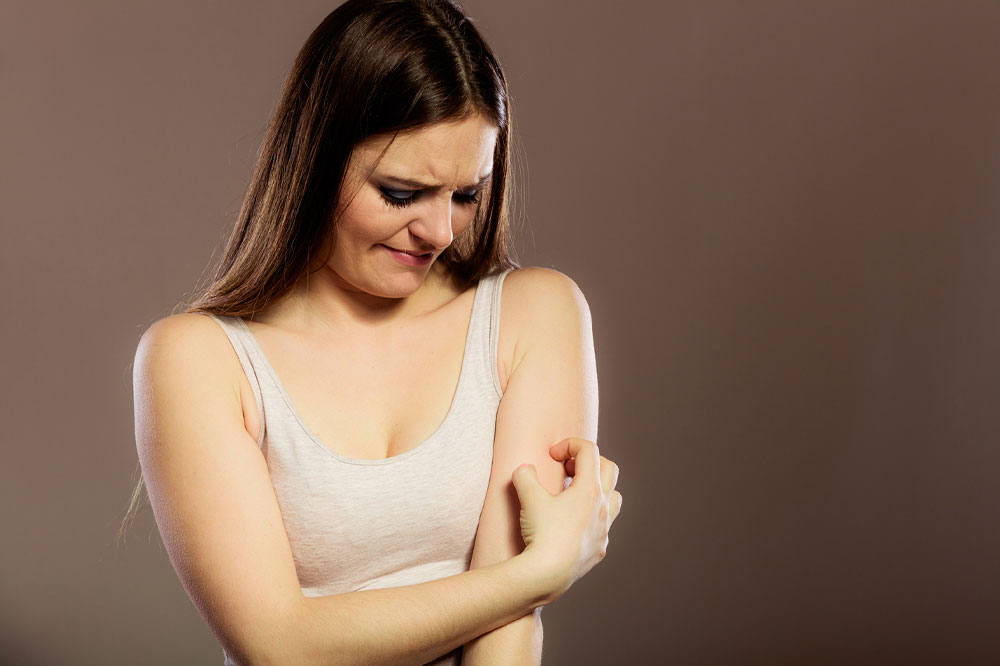Understanding Bed Bug Bites and How to Deal With Them
Bed bugs are tiny blood-sucking pests that invade homes, crawling through walls, beds, and ceilings. They typically attack at night, but their bites may not cause severe health issues or diseases. The mosquito bite-like bumps can be cleaned with soap and water, and persistent itchiness can be treated using remedies or creams. However, some people can experience allergic reactions, so it is important to quickly eliminate these bugs, recognize the signs, and treat the bites.
Where can you see bed bug bites?
Bed bugs leave tiny, rash-like bumps on the skin. During an infestation, sections of exposed skin are vulnerable to the bites.

Symptoms
Most people may not even feel the bite and experience no pain initially. The only visible sign then is red dots and swelling around the spots. However, people who are hypersensitive to these bites might also show certain symptoms, which can appear soon after being bitten or have a delayed onset. People usually experience redness, irritation, and inflammation around the spots. Other common symptoms are:
Itchy raised bumps with a clear center
Small red bumps arranged in a straight or zigzag pattern (clusters)
Red itchy bump with a light surrounding area and a dark center
Pain and burning sensation
Tiny spots of blood on the bedding or clothes
Flat or raised patches of inflamed skin
Red bumps surrounded by hives or blisters
Some people may have a severe reaction to the bed bug bites, which might call for a doctor’s intervention.
Fever
Difficulty in breathing
Swollen tongue
Feeling sick
Blisters
Irregular heartbeat
Identifying bed bug bites
If one or more of the symptoms mentioned above are observed, one may have been exposed to bed bugs. One can identify bed bug bites if they notice the bumps after waking up, which were not visible before climbing into bed the previous night. Further, one can verify the cause of rashes on their skin by looking up bed bug bites images online and comparing them to their own spots. However, it is important to check and rely only on credible sources.
It is also equally important to identify the bugs and be able to distinguish them from other common house pests. It might not be easy to spot bed bugs around the house with the naked eye because the younger bugs can be as tiny as 5mm. Additionally, they are either yellowish-white or clear-colored. The older bed bugs are oval-shaped and are about the size of an apple seed, i.e., approximately 5–7 mm long. They could be anything between reddish-brown, light-brown, and tan in color.
Treatment options
The bumps usually go away on their own in 1–2 weeks, as treatment is not required for mild to moderate symptoms. However, if the swelling and irritation do not subside, the concerns should be communicated to the doctor. A few treatment options may be recommended to relieve the symptoms. The primary bed bug bites remedy is cleaning the affected area with soap and warm water. For people with persistent itchiness and a few other symptoms, treatment for bed bug bites could include antihistamines or topical medications and anti-itch creams. Some people may also have a severe reaction to the bites and can exhibit symptoms of an allergic reaction. This can be treated with the help of injectable treatment options and antihistamines. Other prescription options are offered to those who develop an infection.
How to get rid of bed bugs?
The most effective bed bug bites remedy is the elimination of bed bugs, which means washing and cleaning the infected areas that the bugs have invaded. Some practices that can help get rid of these pests are:
Scrubbing mattresses with stiff brushes can help easily remove the insects and their eggs from the bed. They can then be eliminated using a vacuum cleaner.
Frequently vacuum the bed and its surroundings. During an infestation, clear the vacuum and carefully dispose of the vacuum bag by sealing it in another bag. Practice extra caution and dump the bag in a trash can outside the home.
Use a thick mattress cover that can prevent the bed bugs from traveling in and out.
Glue loose wallpaper and repair cracks and broken furniture, effectively removing bed bugs’ hiding places. The insects can seek refuge in these crevices.
Avoid cluttering the bed and the areas around it.
Regularly wash curtains, bedding, and linens in hot water. Drying them well reduces the chances of bed bug infestation. Additionally, drying items like shoes and stuffed animals at the highest setting for a prolonged period of time can also help prevent the pests from finding warm hiding places.
Seek professional help for thorough extermination to eliminate bed bugs.
